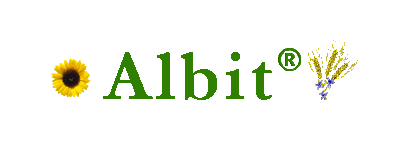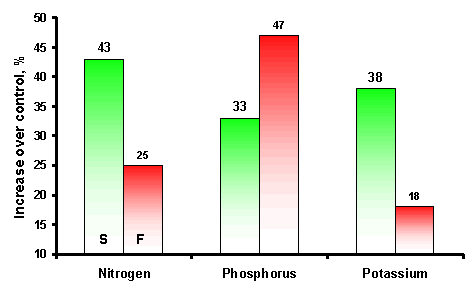|
|
Questions on influence of Albit on soil fertility and phytosanitary
condition of soil are reviewed here. Besides plant growth stimulation, Albit is able to improve mineral uptake of plants. In other words, Albit acts as a soil bioremediant and indirectly as fertilizer. There are several explanations of this activity: Fig. 24. Increase of nutrient uptake from soil (S) and fertilizers (F) due to treatments with Albit (Agrochemistry Department of Moscow State University, 2000). Firstly, Albit contains balanced starting set of macro- and microelements (nitrogen, phosphorus, potassium, magnesium, sulphur and others), and since that our product may be regarded to as fertilizer on the ground of its composition. Of course, low application rates of Albit (30-50 ml/tonne of seeds or hectare) are unable to supply plants with nutrients in full, but one-time application of all necessary nutrients provides high plant growth effect in early stages of development, which is a basis of future effective utilization of nutrients from other sources. Secondly, Albit increases efficiency of mineral utilization by plants. It is well known, that plants utilize nitrogen, potassium and phosphorus (NPK) of mineral fertilizers only partially. For example, utilization of phosphoric fertilizers is just about 20%. Plant growth regulators can increase this portion. As it was demonstrated in trials carried out in Agrochemistry Department of Moscow State University (1999), treatment with Albit increased uptake of nitrogen, phosphorus and potassium by 25%, 47% and 18% respectively (Fig. 24). In addition, treatments with Albit decreased consumption of nitrogen, phosphorus and potassium necessary for grain formation by 2-7% Application of Albit reduced nitrogen consumption for unit of commodity output by 3.7-7.0 mg, and potassium consumption by 11.4 mg. Application of Albit increased NPK transport into spring wheat grain by 10-70%, into straw by 2-45%, depending on agrochemical conditions. High auxin activity of Albit increases transport of nutrients into plant tissues treated with Albit (attractant activity). Thus, Albit increases efficiency of mineral fertilizers. Joint application of Albit and fertilizers in details is described here. Thirdly, besides direct influence on plants, Albit also improves nutrient supply of crops due to its positive influence on favorable soil microflora. Generally, necessary nutrients are present in sufficient amounts, but in hardly consumable form (insoluble, adsorbed). Bacteria of soil microbial community are able to solubilize certain amounts of unutilizable phosphorus and potassium and convert atmospheric nitrogen into consumable for plants form. Albit supports amplification of such bacteria (nitrogen fixing, plant growth stimulating, etc.). According to data of Agrochemistry Department of Moscow State University, application of Albit increased soil nitrogen uptake of plants by 43%, phosphorus uptake by 33%, potassium uptake by 38% (Fig.24). Owing to improvement of natural nitrogen fixation, hectare rate of Albit (40 ml) containing just 9.43 g of urea, is able to substitute up to 40 kg of urea per hectare (approximately 4200 times larger amounts). Additional phosphorus supply of plants also increases resistance of cereals to root rots, since phosphorus suppresses development of such diseases due to improvement of rootage development. Table 17. Influence of Albit on consumption of nitrogen and phosphorus fertilizers by plants grown in averagely cultivated sod-podzol soil (Agrochemistry Department of Moscow State University, 2000).
Due to both increase of nutrient uptake efficiency and provision with additional nutrients from soil, reduction of fertilizers consumption becomes possible. According to data of Agrochemistry Department of Moscow State University, application of Albit is able to replace about 18.7 kg/hectare of a.i. nitrogen (N2 O5) and 14.2 kg/hectare of phosphorus (P2 O5), i.e., 20-50% of standard application rates (these data are obtained in laboratory, under field they might be a bit lower, about 10-30%) Agrochemical properties of Albit were thoroughly studied in vegetation trials carried out by Agrochemistry Department of Moscow State University (1999): Plants were treated with Albit according to standard methodology (presowing seed treatment, 15/60 ml/tonne, double foliar spraying in EC stages 20-29 and 30-39, 30-150 ml/hectare). Solution remaining after presowing treatment was used for additional soil treatment (0.9 ml/pot). Rates of active ingredients in mineral fertilizers were 0, 0.05, 0.1, 0.15 g/kg of soil (rate of 0.1 g/kg was considered as optimal). Nitrogen, potassium and phosphorus were applied in ratio 1:1:1. Lack and excess of active ingredient was obtained through 50% increase of decrease of rate. Thus, each element was used in ratio 0.5, 1 ่ 1.5 relatively to two other elements (i.e., 0.5:1:1, 1:1:1 ่ 1.5:1:1). Application of Albit decreased consumption of nutrients (NPK) necessary for grain formation up to 88-93% of original one. Due to Albit, nitrogen uptake in fertilizers-free set was increased by 43%, phosphorous uptake by 33%, potassium uptake by 38%; in set treated with optimal rate by 25, 47 and 18 % respectively. Calculations of Albit efficiency and examination of its participation in feeding of barley (performed according to Boldyrevs method for calculation of fertilizer rates for prospected yield by complex analytical foliar diagnostics) demonstrated, that Albit is able to replace 14.1-21.3 kg of N2 O5 /hectare and 9.2-15.1 kg of P2 O5 /hectare depending on original nutrient provision level. In other words, this corresponds to:
From the agrochemical point of view, Albit doses of 30 ml/tonne, 30-60 ml/hectare were the most effective ones . Under this conditions, relative grain yield increase was approximately twice higher than straw yield increase, i.e. positive influence of Albit was directed mostly on formation of generative plant structures. Application of higher doses (up to 150 ml) was not so efficient. Generally, application of Albit provided biological grain yield increase from 13.2 to 44.5% and straw yield increase from 20.5 to 49.0%. Thus, joint application of Albit and mineral fertilizers can be very promising. The regularities established by Agrochemistry Department of Moscow State University were confirmed in trials performed by Aleysk Station of Agrochemical Service (Altay krai, 2003). According to results of the trials, application of Albit increased content of nitrogen (by 0.06-0.19%) and phosphorus (by 0.06%) in grain, but did not changed content of potassium. Increase of NPK content was obtained mostly in result of presowing seed treatment (obviously, due to stimulation of rhizospheric microbial community). Foliar sprayings with Albit increased content of calcium in grain (by 0.07%), but decreased NPK content in straw (by 0.03-0.09%), that indicates redistribution of nutrients towards grain induced by Albit.
|
|
|||||||||||||||||||||||||||||||||||||||||
Terms and Conditions
|
|



